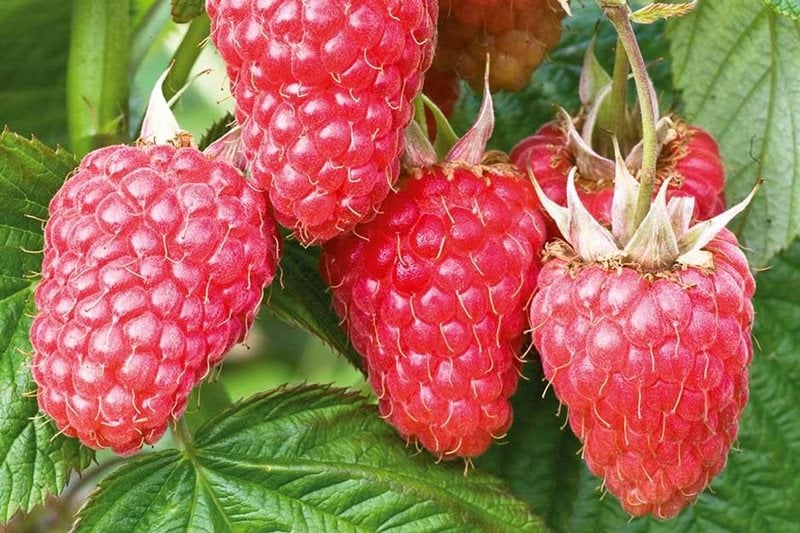
- Botanical name: Rubus idaeus
- Origins: Native to Europe and northern Asia, archaeological evidence suggests that we have been eating raspberries since the Palaeolithic era. Separate but similar raspberry species occur in temperate areas of North America.
- First cultivated: The Roman agricultural writer, Palladius, documented the cultivation of raspberries in the fourth century AD. King Edward I is credited with encouraging the cultivation of raspberries throughout England in the thirteenth century.
- Types: There are over two hundred varieties of raspberries. Popular summer-fruiting varieties include 'Glen Ample' and 'Malling Minerva'. 'Autumn Bliss' is a classic autumn-fruiting variety.
- Skill level: Easy.
- Preferred location and conditions: Raspberries prefer a sunny, sheltered position but can tolerate partial shade. Soil should be rich, moisture-retentive and, ideally, slightly acidic.
- Good for containers: Generally not, although there are some compact, dwarf varieties available such as ‘Ruby Beauty’, which are suitable for container growing.
- Harvest time: June to October, depending on variety.
- See RHS advice on growing raspberries.
Did you know?
We’ve been eating raspberries ever since our cave-dwelling ancestors stumbled across them during the Palaeolithic era. The ancient Romans wrote about them, medieval Europeans feasted on them, and the Native Americans used them as medicine. And for good reason; raspberries are a delicious and health-boosting fruit.
A member of the rose family, the raspberry derives its name from the mid-fifteenth century word raspise, meaning “a sweet rose-coloured wine”. The Eurasian raspberry's botanical name, Rubus idaeus, means “bramble bush of Ida”, which refers both to Mount Ida, where the fruit purportedly grew in abundance, as well as the nymph, Ida, who was entrusted to look after the baby Zeus. The legend tells us that raspberries were originally white, but Ida pricked her finger on a thorn while picking the fruit for the young Zeus, forever staining them red with her blood.
But don’t let that put you off. These days, there are over two hundred varieties of raspberries available, including purple, gold and black types. Best eaten fresh from the plant, raspberries also lend themselves to puddings, cakes, jams and drinks.
They contain powerful antioxidants and are an excellent source of vitamin C, manganese and fibre. Raspberries are anti-inflammatory, and as part of a healthy balanced diet can help boost the immune system, improve cardiovascular health, and reduce the risk of obesity. Like all berries, they contain anthocyanins which have been proven to prevent the brain damage and memory loss associated with aging. They’re also high in polyphenolic compounds which can help lower the risk of cancer.
The leaves of the raspberry plant are just as nutritious as the fruit, and are usually dried and consumed as a tea. Raspberry leaf tea is believed to have many health benefits, from reducing inflammation, to preventing nausea, but it is most commonly thought to ease childbirth. Although there’s little scientific evidence to substantiate this, it’s worth noting that Native American women have been using raspberry leaves to help expectant mothers for thousands of years.
In medieval times, wealthy Europeans ate raspberries for food and medicine, as well as using them for pigment. They also featured in early Christian artwork as a symbol of kindness.
Raspberries are highly perishable, so it’s best to eat them immediately, although they don’t lose significant quantities of their nutritional value if frozen correctly, and they still taste delicious. If freezing, wash the raspberries, dry them completely, then place them in a single layer on a baking tray and pop in the freezer. Once they’re solid, transfer to a container or bag, and freeze until required. You’ll be able to enjoy the sweet, summery taste of raspberries throughout the year.
Text provided by Mr Fothergills

